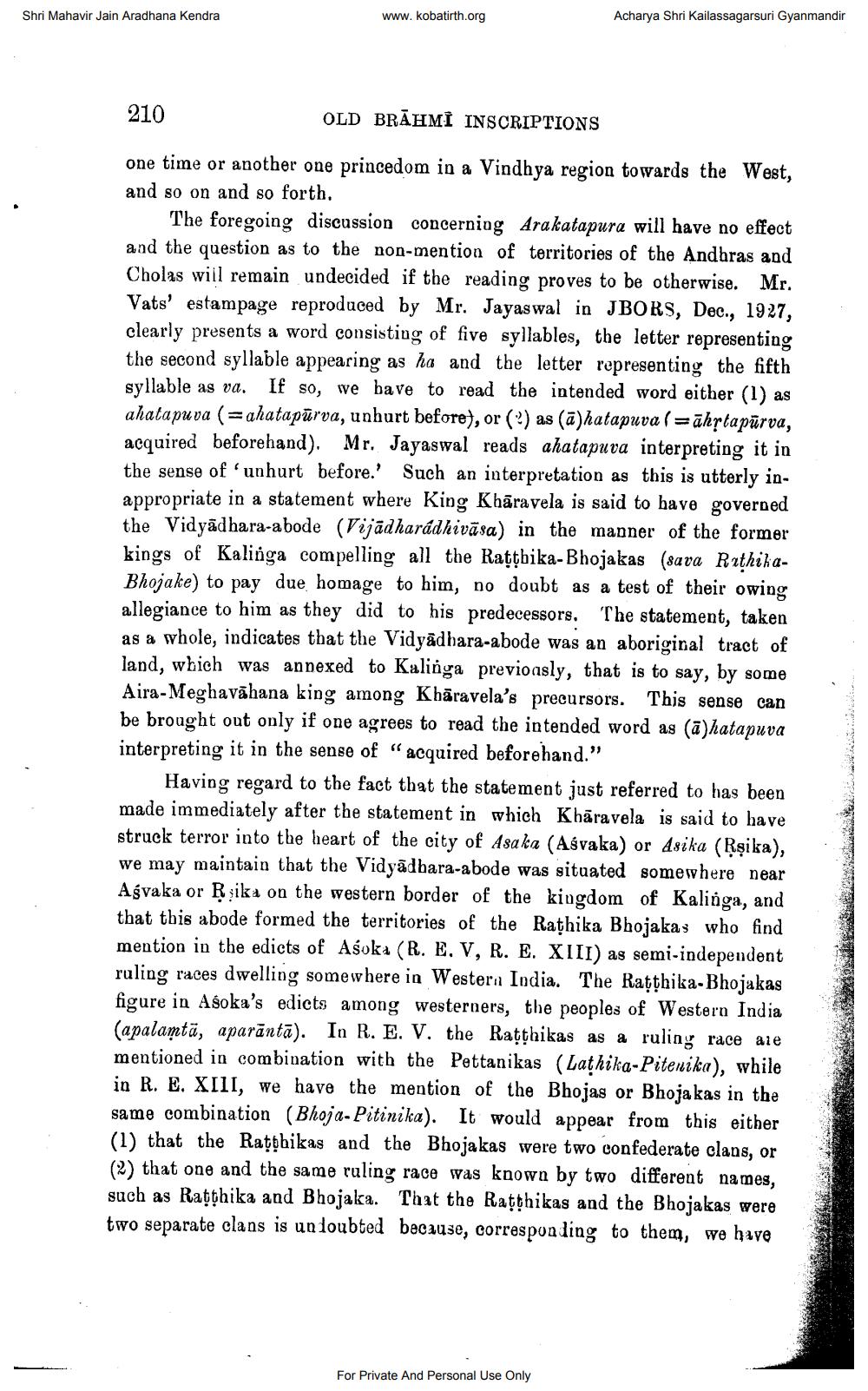________________
Shri Mahavir Jain Aradhana Kendra
www.kobatirth.org
Acharya Shri Kailassagarsuri Gyanmandir
210
OLD BRAHMI INSCRIPTIONS
one time or another one princedom in a Vindhya region towards the West, and so on and so forth.
The foregoing discussion concerning Arakatapura will have no effect and the question as to the non-mention of territories of the Andhras and Cholas will remain undecided if the reading proves to be otherwise. Mr. Vats' estampage reproduced by Mr. Jayaswal in JBORS, Dec., 1927, clearly presents a word consisting of five syllables, the letter representing the second syllable appearing as ha and the letter representing the fifth syllable as va. If so, we have to read the intended word either (1) as ahatapuva (=ahatapurva, unhurt before), or (2) as (a)hatapuva (=ahṛtapūrva, acquired beforehand). Mr. Jayaswal reads ahatapuva interpreting it in the sense of unhurt before.' Such an interpretation as this is utterly inappropriate in a statement where King Kharavela is said to have governed the Vidyadhara-abode (Vijadharádhiväsa) in the manner of the former kings of Kalinga compelling all the Rattbika-Bhojakas (sava RathikaBhojake) to pay due homage to him, no doubt as a test of their owing allegiance to him as they did to his predecessors. The statement, taken as a whole, indicates that the Vidyadhara-abode was an aboriginal tract of land, which was annexed to Kalinga previously, that is to say, by some Aira-Meghavahana king among Khāravela's precursors. This sense can be brought out only if one agrees to read the intended word as (a) hatapuva interpreting it in the sense of "acquired beforehand."
Having regard to the fact that the statement just referred to has been made immediately after the statement in which Kharavela is said to have struck terror into the heart of the city of Asaka (Asvaka) or Asika (Rṣika), we may maintain that the Vidyadhara-abode was situated somewhere near Agvaka or Ṛsika on the western border of the kingdom of Kalinga, and that this abode formed the territories of the Rathika Bhojakas who find mention in the edicts of Asoka (R. E. V, R. E. XIII) as semi-independent ruling races dwelling somewhere in Western India. The Raṭṭhika-Bhojakas figure in Asoka's edicts among westerners, the peoples of Western India (apalamta, aparanta). In R. E. V. the Ratthikas as a ruling race ale mentioned in combination with the Pettanikas (Lathika-Pitenika), while in R. E. XIII, we have the mention of the Bhojas or Bhojakas in the same combination (Bhoja-Pitinika). It would appear from this either (1) that the Raṭṭhikas and the Bhojakas were two confederate clans, or (2) that one and the same ruling race was known by two different names, such as Raṭṭhika and Bhojaka. That the Ratthikas and the Bhojakas were two separate clans is undoubted because, corresponding to them, we have
For Private And Personal Use Only




